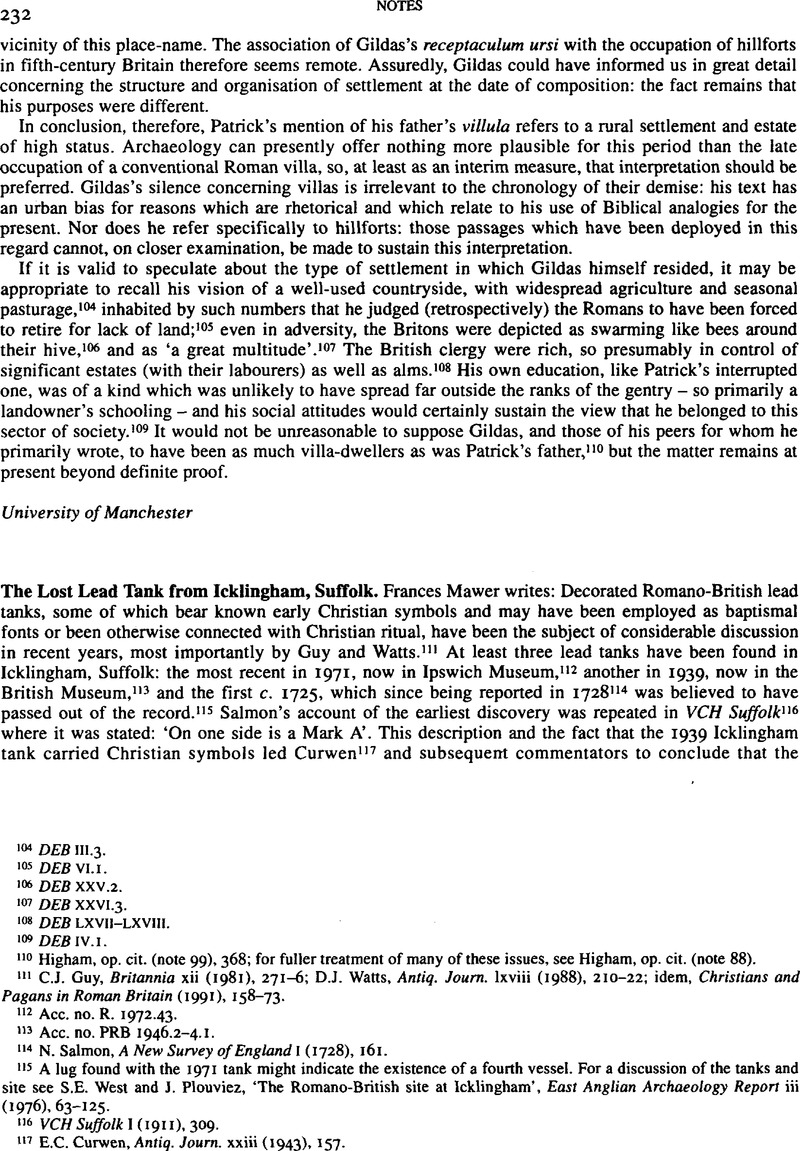Article contents
The Lost Lead Tank from Icklingham, Suffolk
Published online by Cambridge University Press: 09 November 2011
Abstract

- Type
- Notes
- Information
- Copyright
- Copyright © Frances Mawer 1994. Exclusive Licence to Publish: The Society for the Promotion of Roman Studies
References
111 Guy, C.J., Britannia xii (1981), 271–6CrossRefGoogle Scholar; Watts, D.J., Antiq. Journ. lxviii (1988), 210–22; idem, Christians and Pagans in Roman Britain (1991), 158-73.CrossRefGoogle Scholar
112 Acc. no. R. 1972.43.
113 Acc. no. PRB 1946.2-4.1.
114 Salmon, N., A New Survey of England I (1728), 161.Google Scholar
115 A lug found with the 1971 tank might indicate the existence of a fourth vessel. For a discussion of the tanks and site see West, S.E. and Plouviez, J., ‘The Romano-British site at Icklingham’, East Anglian Archaeology Report iii (1976), 63–125.Google Scholar
116 VCH Suffolk I (1911), 309.Google Scholar
117 Curwen, E.C., Antiq. Journ. xxiii (1943), 157.Google Scholar
118 Camden, W. (ed. Gough, R.), Britannia II (1789), 81, pl. II.Google Scholar
119 Acc. no. Z.46783. Photographed by Gwill Owen of the Cambridge Museum of Archaeology and Anthropology.
120 Donovan, H.E., TBGAS lvi (1934), 116, fig. 9.2.Google Scholar
121 JRS xxv (1935), pl. XXXVI.i (wrongly captioned).Google Scholar
122 Watts, op. cit. (note 111).
123 Evidence for iron ring-handles of a different ‘spar-and-ring’ construction exists on tanks from Kenilworth, Oxborough (possibly post-Roman), Wiggonholt, and possibly on an untraced vessel from Six Mile Bottom, Cambs.
124 Conceivably a misreading of 12½. ins as 22½ ins before the conversion to yards.
125 The capacity of the Ireby tank, with diameter 18 ins/45.72 cm and height 67. ins/16.51 cm, was initially published as 10.06 gal. (Richmond, I.A., TCWAAS xlv (1946), 163–71) and subsequently converted to 45.5 litres (Guy, op. cit. (note 111)); it is in fact only 5.97 gal./27.12 litres.Google Scholar
126 Drawn from the author's reconstructions by Sandra Hooper, Department of Archaeology, University Newcastle upon Tyne.
127 West and Plouviez, op. cit. (note 115).
128 It should be noted that none of the tanks is perfectly cylindrical and the published dimensions are unreliable; maximum dimensions have been given here and the capacities are approximations.
129 Guy, C.J., PCAS lxviii (1978), 1–4.Google Scholar
130 University of Cambridge Museum of Archaeology and Ethnology, 30th Annual Report of the Antiquarian Committee to the Senate (1915), 18. I am very grateful to Mr R.R. Milne, Sub-Librarian of Trinity College, for searching the Library's records on my behalf.
131 I am very grateful to Steven Plunkett and Catherine Johns for making available to me the records of the 1971 and 1939 tanks respectively, and in particular to Robin Boast for not only giving me access to both the 1725 tank and its records, but also for arranging for it to be manoeuvred out of storage in order to be photographed.
- 1
- Cited by


